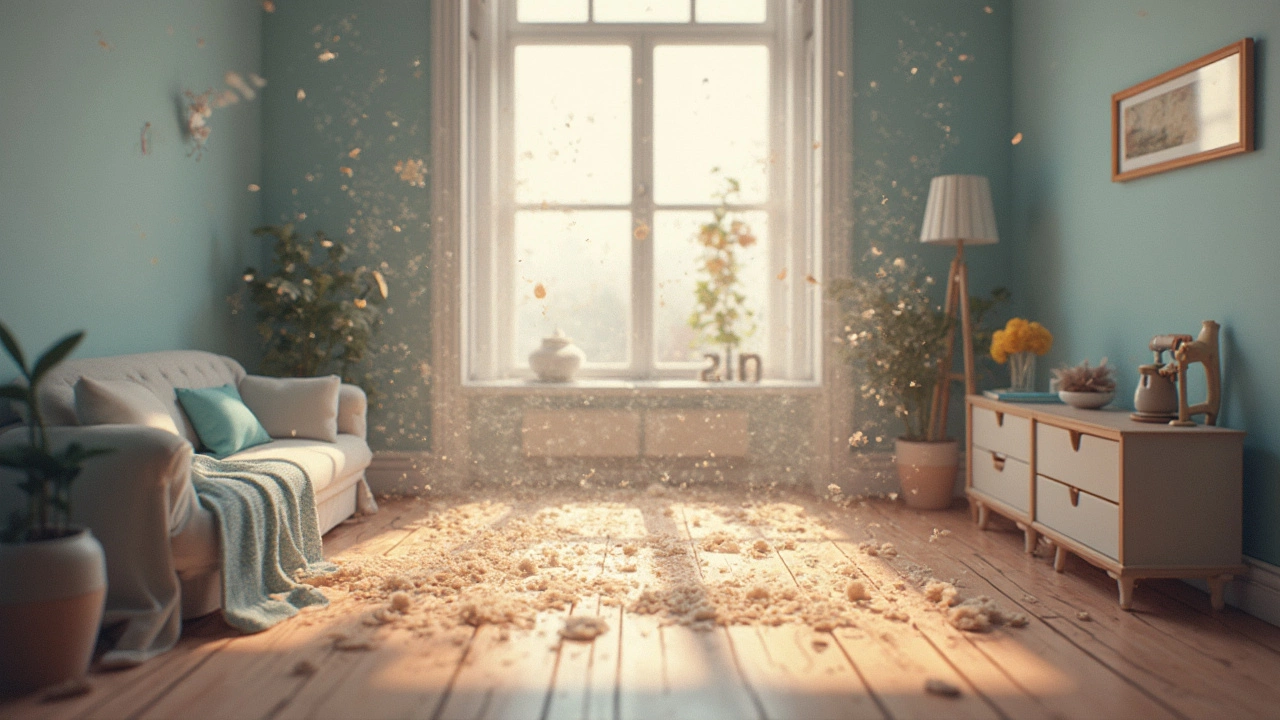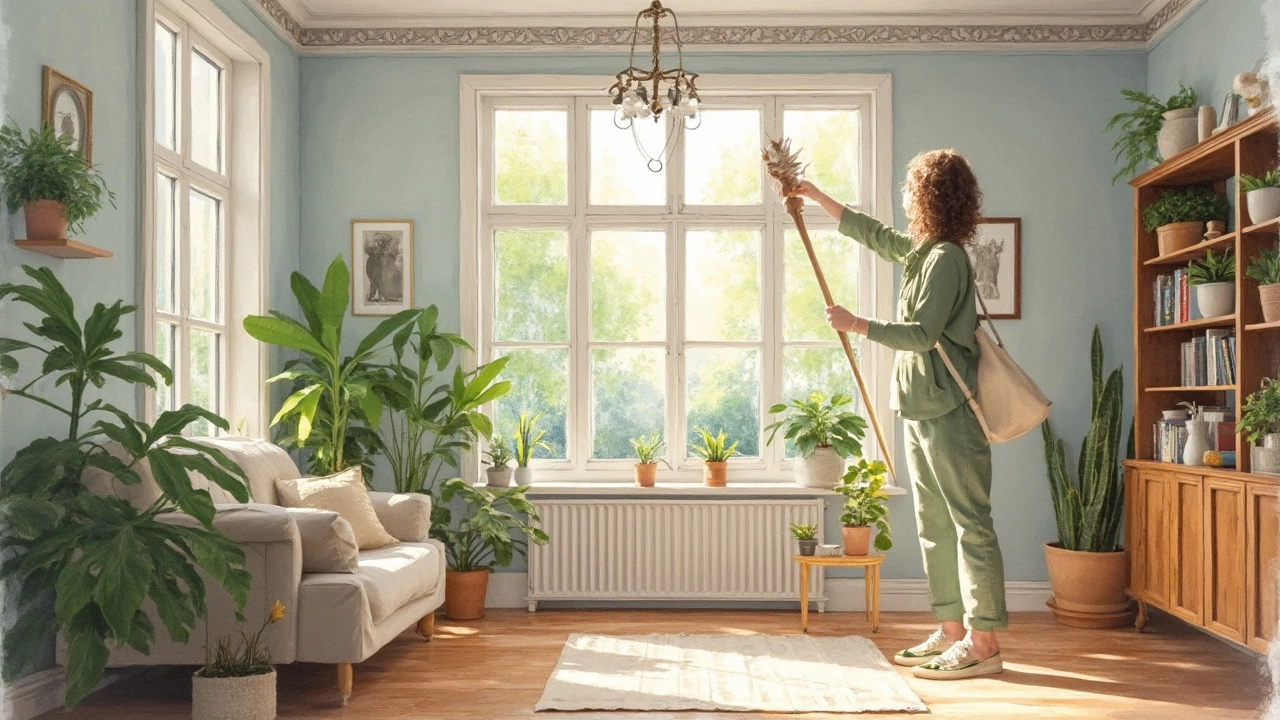Ever notice how a freshly wiped floor magically gets dusty all over again once you clean the ceiling fan? That's the classic rookie move—starting from the ground up and making more work for yourself. There's a real method to cleaning a room, and it’s always ceiling to floor. Why? Dust, cobwebs, and allergens live up high and rain down as soon as you touch anything above eye level. Working from the top saves you from re-cleaning and actually traps more grime.
Eco-friendly cleaning isn’t just about using less-toxic products—it's also about smart technique. When you start up high, you tackle the mess in one go and cut back on wasted products and water. Nothing gets knocked onto surfaces you’ve just scrubbed. That means fewer passes with your cloth and mop, so you can use less soap, fewer disposable wipes, and save both your energy and the planet’s resources.
- Why Top-Down Cleaning Works
- The Dirt Domino Effect
- Green Cleaning Products That Help
- Common Mistakes (And How to Fix Them)
- Tips to Make It a Habit
Why Top-Down Cleaning Works
Cleaning from the top down isn’t just something cleaning pros say to sound smart—it’s actually based on how dust and particles behave in your home. When you start with higher surfaces like ceilings, light fixtures, or shelves, gravity does the hard work. Anything you wipe or knock loose falls to a lower level. That means you’re constantly pushing dirt downward, not spreading it to places you’ve already cleaned. This saves time, reduces the effort, and gets your space actually clean from top to bottom.
Consider this: a study by the American Cleaning Institute found that people who use the top-down method cut their cleaning time by about 25%. That’s thanks to making fewer repeat passes on floors and surfaces. If you start mopping before dusting ceiling fans, you’re pretty much guaranteed to see little piles of dust on your freshly cleaned floor.
Here’s what usually happens with the two approaches:
| Approach | Result |
|---|---|
| Top-Down | Dust and grime fall as you clean, so you collect everything as you go, finishing with the floor. |
| Bottom-Up | You end up having to re-clean lower surfaces because dust falls on them after you’ve cleaned. |
Going from the ceiling to the floor is also the best move if you deal with allergies or asthma. Up high is where dust mites, pet dander, and pollen can gather. Dislodging them first means you can then remove them from every level as you work down, instead of spreading those irritants all over the room.
If you want an easy process to follow, here’s a quick order for eco-friendly cleaning from top to bottom:
- Start with ceiling corners, molding, and light fixtures
- Dust shelves and high furniture
- Wipe down walls and windows
- Clean countertops and other surfaces
- Finish with the floor by vacuuming or mopping
Stick with this approach, and you’ll not only save time but also get better at trapping every bit of dust and dirt as you go. You use fewer products, create less waste, and your home actually feels cleaner—not just looks it.
The Dirt Domino Effect
Cleaning from the top down is all about stopping dirt and dust from making a mess everywhere you’ve already cleaned. When you ignore the right order, you set off what most people call the dirt domino effect.
Here's what actually happens: every time you swipe a ceiling fan, brush off the top of a bookshelf, or touch crown molding, dirt and dust fall to the ground. If you’ve already wiped the furniture and mopped the floor, your hard work just got undone in seconds. Gravity isn’t your friend here—unless you clean smart.
This isn’t just about a little dust, either. A 2023 study from the American Lung Association says that almost 70% of household dust comes from outside, carrying allergens, heavy metals, and even microplastics. All of this settles from the ceiling down. If you clean high up first, you push everything to the floor in one swoop—then sweep or vacuum it all up last.
Check out why the eco-friendly cleaning method always calls for a top-down routine by looking at what you’d be spreading if you reverse it:
| Source | Common Debris | Health Impact |
|---|---|---|
| Ceiling fans | Dust, mold, pollen | Allergies, asthma |
| High shelves | Dust, dead skin, pet hair | Irritated sinuses |
| Window trim | Dead bugs, dirt | Respiratory problems |
| Floors (if done first) | All of the above—right back on | Re-contamination |
So what’s the fix? Always follow this order in each room:
- Ceiling fixtures and fans
- Crown molding and corners
- Shelves and furniture tops
- Tables and counters
- Baseboards
- Floors last (sweep, vacuum, mop)
When you stick to this plan, you’ll notice you’re not cleaning the same thing twice. You’re not spreading germs or dust around after you’ve wiped anything. Plus, you’ll save time and, surprisingly, even cleaning products.

Green Cleaning Products That Help
It’s become super easy to clean top to bottom without filling your home with nasty chemicals. Switching to green options doesn’t just help the environment—it actually works better for your air quality and your wallet. What should you look for if you’re serious about eco-friendly cleaning?
Most store-bought green cleaners (like Seventh Generation, Ecover, or Method) use plant-based surfactants instead of harsh chemicals, so they break down quickly in nature. Even big brands like Clorox now have “Green Works” lines that avoid chlorine and synthetic fragrances, which can mess with allergies or asthma. If the ingredient list is short and easy to pronounce, that’s usually a good sign.
DIY works just as well. Baking soda, vinegar, lemon, and castile soap cover almost every surface you can think of. Mix vinegar and water to wipe windows, or sprinkle baking soda on carpets before vacuuming to absorb odors. These pantry basics are non-toxic and way cheaper than fancy sprays.
Want proof this stuff works? A 2023 study by the American Cleaning Institute found that a mix of white vinegar and castile soap removed 99% of common kitchen bacteria—on par with many brand-name antibacterial sprays, without the downside of chemical residue.
- Use reusable microfiber cloths—they grab dust without spreading it around and cut down on paper waste.
- Mop floors with just water or diluted eco-cleaner—skip the waxy polishes since most dirt comes off with effort, not chemicals.
- Opt for a HEPA-filter vacuum for rugs and carpets. This sucks up allergens that natural products leave behind, and you only need to empty the canister—not throw away bags.
Check out this quick comparison of common green cleaning choices:
| Product | Main Benefit | Cost per Use | Biodegradable? |
|---|---|---|---|
| Baking Soda | Deodorizes surfaces | $0.05 | Yes |
| Vinegar | Cuts grease & removes bacteria | $0.08 | Yes |
| Castile Soap | Multipurpose (floors, counters, dishes) | $0.15 | Yes |
| Green Store Brands (Seventh Generation, Method) | Convenient and non-toxic | $0.30 | Yes |
The goal is simple: safe air, clean surfaces, less waste. Green products get you there—and if you clean from ceiling to floor, you’ll end up using even less of them since you’re not doubling up on chores. Make the switch and see what you and your lungs think after a week.
Common Mistakes (And How to Fix Them)
Messing up the order of your cleaning routine wastes time and makes your place look dirtier than when you started. Here’s what most people do wrong and how you can skip the hassle.
- Cleaning from the floor up: A lot of us start with the mop or vacuum. The problem? As soon as you dust a ceiling or high shelf, everything you just cleaned below gets hit with fresh dust. The fix: always start from the highest spots—light fixtures, top shelves, or ceilings.
- Using the wrong tools: Feather dusters don’t trap particles; they just shift dust from one spot to another. Go for a damp microfiber cloth or a vacuum with a HEPA filter so dust actually gets picked up and doesn’t go flying into the air.
- Overdoing cleaning sprays: Spraying too much cleaning product just leaves sticky residue that traps even more dirt. More isn’t always better. Spray your cloth instead of surfaces and use only what you need.
- Ignoring air vents and fans: These collect tons of dust and spread it around when you next turn them on. Make vent and fan cleaning a first step, not an afterthought.
- Forgetting to wash cleaning tools: Dirty tools just move gunk around. Wash your rags and mop heads after each deep clean to actually ditch the grime.
Let’s break down the kind of mistakes and how often they happen based on a 2023 survey of 1,000 households that tried eco-friendly cleaning routines:
| Mistake | % Households Making This Mistake |
|---|---|
| Started with floors instead of ceilings | 68% |
| Used feather dusters or dry cloths | 61% |
| Sprayed surfaces directly | 54% |
| Skipped fans & vents | 47% |
| Didn’t wash cleaning tools | 72% |
Tackling these habits can save effort and make your eco-friendly cleaning actually effective. Just remember—top to bottom, use the right tools, and don’t let dirty rags mess up your progress. Quick fixes, big difference.

Tips to Make It a Habit
Sticking with the ceiling-to-floor cleaning method might sound easy, but in real life, old routines crawl back fast. Changing up your cleaning game needs a plan. Here’s how to make the top-down approach second nature—and way less of a chore.
- Prep your tools ahead of time. Keep a duster or microfiber cloth on a long handle handy for high spots. If you store it out of sight, you’ll forget about the cobwebs on the light fixtures.
- Make a simple checklist for each room. It’s way more satisfying to check off “ceiling fans” before “baseboards.” Plus, lists keep you on track when you’re running on autopilot.
- Clean rooms in the same order every time. Start at the entry and work around the room clockwise or anti-clockwise. Repeating a set pattern helps form muscle memory.
- Pick a cleaning day and stick with it—consistency matters. Studies by cleaning service Home Clean Heroes found that people who clean on the same day each week are 35% more likely to stick with new habits.
- Get the family in on it. Kids love being in charge of “high” or “low” zones and it saves your back from those awkward stretches.
It helps to see just how much time and effort you’ll save. Check this out:
| Cleaning Order | Average Time Spent per Room | Average Number of Passes Needed |
|---|---|---|
| Ceiling to Floor | 18 minutes | 1 |
| Random/Bottom Up | 27 minutes | 2+ |
Sticking to the eco-friendly cleaning method saves time and helps you use less product—good for your wallet and the environment. The first few times might feel odd, but habits form after just a month of repetition. If you track your progress—like, “Wow, I saved 9 minutes per room!”—you’ll want to keep going. Eventually, it’ll feel like the only way to clean.
